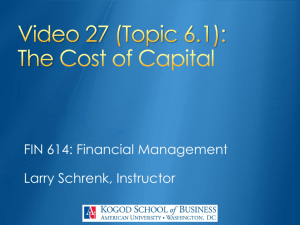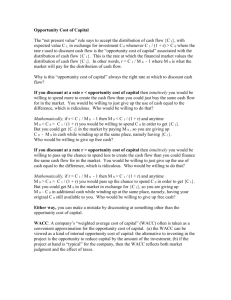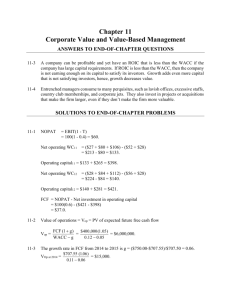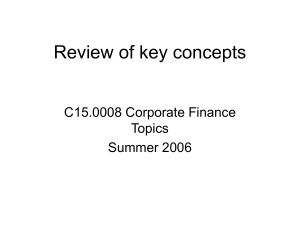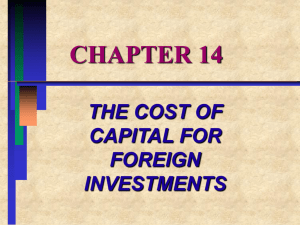Introduction to Discounted Cash Flow Analysis
advertisement
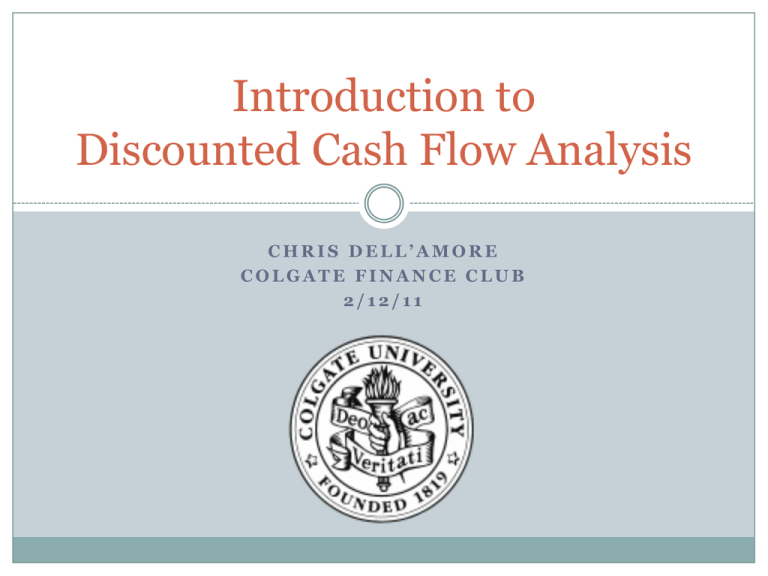
Introduction to Discounted Cash Flow Analysis CHRIS DELL’AMORE COLGATE FINANCE CLUB 2/12/11 What is a DCF? Value can be derived from the present value of its projected free cash flows Intrinsic Value ≠ Market Value Assumptions: Growth rates (i.e. sales) Profit margins CAPEX Net Working Capital requirements When do we use a DCF? No “true” comparable companies Times of economic turmoil Flexibility in assumptions Fundamental approach Process of a DCF Analyze Target and Determine Drivers 2. Project the Free Cash Flow (FCFs) 3. Calculate Weighted Average Cost of Capital (WACC) 1. • Capital Asset Pricing Model (CAPM) 4. Calculate Terminal Value (TV) 5. Calculate Present Value (PV) Disclosure: This presentation will go over the basics of each step and will not analytically delve into the development of each calculation. Target Analysis (Step 1) Public SEC filings, earnings call transcripts, analyst research and Management Discussion and Analysis portion of the 10-K and 10-Q Private: Confidential Information Memorandum (CIM), analyst research, trade journals and SEC filings Business model Financial profile End markets Competitors Driver Analysis (Step 1) Sales Growth Internal: new facilities, new products, capital efficiency improvements, costumer contract expansion External: acquisitions, end market trends, regulatory changes consumer buying patterns Profitability Management, brand, customer base, marketing, technology Free Cash Flow Generation CAPEX (i.e. owning vs. leasing) Projecting Free Cash Flows (Step 2) Historical Performance Projection Period Length (~5-10 years) Best Case, Base Case, Worst Case Projections: Sales, COGS and SG&A, EBITDA, EBIT, Tax, D&A, CAPEX, NWC EBIAT /NOPAT= EBIT – Marginal tax rate (~35-40%) NWC = Current Assets – Current Liabilities FCF= EBIAT + D&A - CAPEX - ΔNWC Calculating WACC (Step 3) Represents the weighted average of the required return on the invested capital Debt and Equity have different risk and tax benefits/detriments Determine target capital structure Debt-to-total capitalization [D/(D+E)] Equity-to-total capitalization [E/(D+E)] Calculating WACC (Step 3) (Cost of Equity) (Cost of Debt) Calculating WACC (Step 3) Estimate Cost of Debt (rd) Credit Profile at target capital structure Bonds: current yield on all outstanding issues Credit Facilities: analyzed by DCM team internally Tax-effect your cost of debt by marginal tax rate Estimate Cost of Equity (re) – CAPM Annual rate of return that equity investors expect to receive Use CAPM to find this rate re = rf + βL * (rm - rf ) Disclosure: Did not discuss process of unlevering and relevering beta for sake of simplicity Calculating WACC (Step 3) WACC = ( E (D+E) ) (re) + ( D (D+E) ) (1-t)(rd) D = market value of debt E = market value of equity rD = discount rate for longterm debt re= discount rate for equity (from CAPM) Calculating Terminal Value (Step 4) Captures the value beyond the projected period Steady state; accounts for ~75% of valuation Exit Multiple Method (EMM) Based on the current LTM trading multiples of comps Must normalize to account for peaks and troughs in industry TV = EBITDAn * Exit Multiple Perpetuity Growth Method (PGM) Treats company’s terminal year FCF as a perpetuity growing at an assumed rate. (Must be cautious when choosing growth rate) TV = FCFn * (1 + g) (re -g) Calculating Present Value (Step 5) Time value of money Discount Rate: Fractional value representing the present value of a dollar received at a future date given an assumed discount rate (WACC) Discount Factor = 1 (1 + WACC)n PV of FCFn = FCFn *Discount Factor Final Valuation Enterprise Value Discount and sum the present values of the FCF for each period and the TV Equity Value Implied Equity Value = Enterprise Value – (Net Debt + Preferred Stock + Non-controlling Interest) Share Price Implied Share Price = Implied Equity Value Fully Diluted Shares Outstanding Works Cited Pearl, Joshua, and Joshua Rosenbaum. Investment Banking Valuation, Leveraged Buyouts and Mergers & Acquisitions. Hoboken: John Wiley & Sons, 2009. Print.
